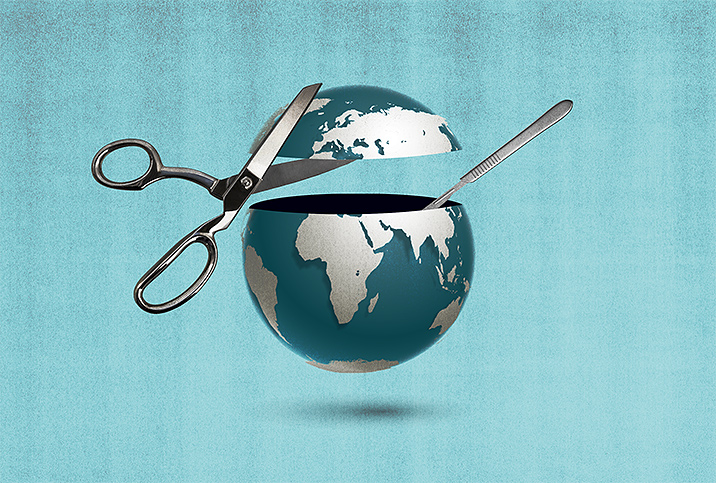How Many Men Are Circumcised Worldwide?

Circumcision is a ritual whose roots spread back through the ancient world, and it's still commonplace in countries with large Jewish and Muslim populations in particular. Yet the last few decades have seen growing opposition from the controversial "intactivist" movement, which likens the removal of penis foreskin—especially when the procedure is performed on infants—to mutilation.
Given those disagreements, it's worth asking: Just how many penises are circumcised worldwide?
In 2016, Brian J. Morris, Ph.D., set out to expand on leading 2007 research on male circumcision statistics, conducted by the World Health Organization (WHO).
"The aim was to simply add to the findings of that study, which included a more limited number of countries," he said.
Although approximately half of all male circumcisions can be attributed to religious and cultural reasons, there are other factors at play, like penile health.
The result was an in-depth report published in Population Health Metrics, which has since been transformed into a handy, color-coded map. To collate the data, Morris and his team of researchers scoured various research databases to source figures, focusing predominantly on studies with samples of men age 15 and over. In countries with no available figures, the team instead cited the proportion of the population required by either their religion or their culture to be circumcised.
Percentages varied hugely—from 0.1 percent in countries like Armenia, Belize and Laos to a staggering 99.8 percent in Afghanistan, with the global average falling somewhere between 36.7 percent and 38.7 percent. Rates were particularly high across the Middle East and West Africa, as well as in the U.S., where an estimated 71.2 percent of men are circumcised.
"The results didn't surprise us at all," stated Morris, a longtime advocate for circumcision.
Although approximately half of all male circumcisions can be attributed to religious and cultural reasons, there are other factors at play, like penile health. Various studies of heterosexual men in countries with high rates of HIV have found male circumcision to lower rates of female-to-male transmission, yet the same can't be conclusively said of MSM (men who have sex with men). Despite this, the Joint United Nations Programme on HIV/AIDS continuously recommends male circumcision as a preventive tactic, and actively sets targets for "voluntary male circumcision" in countries disproportionately impacted by HIV.
Research has also linked male circumcision to lower rates of genital herpes, HPV and penile cancer, whereas doctors worldwide will recommend the operation to tackle issues like balanitis and phimosis. In fact, when the color-coded map based on Morris' study was shared to Reddit, a lively discussion led to a circumcised man in Greenland—who posted his story anonymously—explaining he chose to get cut because his foreskin was "too tight for comfortable sex. I realized when I got older that sex wasn't meant to always hurt," he wrote, receiving a plethora of well wishes for his newly cut penis.
Especially in countries across Europe that don't have cut cocks as the norm, the chances are comparatively higher of circumcision being carried out as a medical procedure—it's cited as "the most common" reason on the U.K.'s National Health Service (NHS) website. Notably, a summary paragraph in Morris' study explained the authors "assumed a minimum prevalence of 0.1 percent related to male circumcision for medical reasons," which "may be too low, thereby underestimating prevalence in some countries." In other words, even saying a third of the world is cut might still be a conservative estimate.
The last few years have also seen growing numbers of forums dedicated to cosmetic circumcision, as well as websites like My Adult Circumcision. A handful of these guys simply prefer the aesthetic, whereas others chase either "normality" in countries where cut is the norm or the look of the cut cocks showcased in American porn. As a result, clinics like Atlanta's Circumcision Center have developed fabled reputations for beautifying past circumcisions, focusing on looks as well as functionality.
Not everyone has autonomy over their circumcision. The aforementioned 2007 WHO study highlighted neonatal circumcision is commonplace in "Israel, the USA, Canada, Australia, New Zealand and much of the Middle East, Central Asia and West Africa," yet activists have likened it to intersex genital mutilation and lobbied for children to be given a choice. Long-term data is scarce, but a study conducted over more than three decades, published by the Centers for Disease Control (CDC), estimated 6 in 10 babies in the U.S. are circumcised before leaving the hospital.
Despite the controversy, it seems unlikely this millennia-old practice is going anywhere soon. Not only is it a cultural ritual, it has a long, fascinating and truly global history: According to a 2007 article published in Reproductive Health Matters, British royalty were the first in the U.K. to "circumcise their male heirs, creating both a trend and a social status difference in this respect. By the start of World War II, an estimated 80 percent of upper-class males in the U.K. were circumcised compared with 50 percent of working-class men."
Methods have undeniably advanced—although "traditional" circumcisions with a blade and no anesthetic are still rumored to take place within some rural communities—but ethical questions linger around the practice more generally. Whether or not global rates will fluctuate over the next few decades remains to be seen, but cut cocks are here to stay regardless.




















